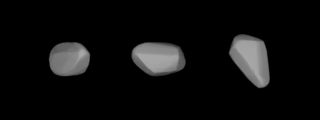
Augusta is a main-belt asteroid, discovered on 31 March 1886 by astronomer Johann Palisa at Vienna Observatory, Austria. The stony S-type asteroid measures about 12 kilometers in diameter. It is the first-numbered member of the Augusta family, after which the small Asteroid family and subgroup of the main-belt has been named. Augusta was named after the German–Austrian writer Auguste von Littrow (1819–1890), widow of astronomer Carl Ludwig von Littrow, who was a former director of the Vienna Observatory.

Silesia is a large Main belt asteroid, about 73 kilometers in diameter. It was discovered by Johann Palisa on 5 April 1886 at Vienna Observatory, Austria.

Tyche is a relatively large main belt asteroid discovered by Robert Luther at Düsseldorf-Bilk Observatory on 4 May 1886. The stony S-type asteroid measures about 65 kilometers in diameter and has a perihelion of 2.1 AU.

Katharina is a small Main belt asteroid orbiting in the Eos family of asteroids, including 513 Centesima and 221 Eos. It was discovered by Johann Palisa on 11 October 1891 in Vienna. It is named after the discoverer's mother.

Phaeo is an asteroid from the central regions of the asteroid belt, approximately 70 kilometers in diameter. It was discovered on 27 November 1891, by French astronomer Alphonse Borrelly at the Marseille Observatory in southern France. The presumably metallic X-type asteroid is the principal body of the Phaeo family and has a rotation period of 17.6 hours. It was named for the Greek mythological figure Phaeo, one of the Hyades or nymphs. Several other asteroids were named for other of the Hyades – 106 Dione, 158 Koronis, 217 Eudora, and 308 Polyxo.

Tamara is a large Main belt asteroid. It is classified as a C-type asteroid and is probably composed of carbonaceous material. It is the largest member and namesake of the Tamara Family, a 264 million year-old sub-family of the collisional Phocaea family.

Persephone is a main belt asteroid. It was discovered by German astronomer Max Wolf on 23 February 1895 in Heidelberg.
Xanthe, minor planet designation 411 Xanthe, is an asteroid from the outer regions of the asteroid belt, approximately 77 kilometers in diameter. It was discovered by French astronomer Auguste Charlois at Nice Observatory on 7 January 1896. The asteroid was named after Xanthe, an Oceanid or sea nymph, and one of the many Titan daughters of Oceanus and Tethys from Greek mythology.
Zähringia, provisional designation 1896 CZ, is a stony asteroid from the intermediate asteroid belt, approximately 14 kilometers in diameter. It was discovered on 7 September 1896, by astronomer Max Wolf at Heidelberg Observatory in Germany. The asteroid was named for the House of Zähringen, a medieval noble family that ruled parts of Swabia and Switzerland.

Cornelia is a large Main belt asteroid. It was discovered by Auguste Charlois on 28 December 1896 in Nice. It is named after Cornelia Africana.
Signe, provisional designation 1900 FM, is a stony asteroid from the background population of the intermediate asteroid belt, approximately 26 kilometers in diameter. It was discovered by German astronomer Max Wolf at Heidelberg-Königstuhl State Observatory on 22 October 1900. The asteroid was presumably named after Signy, a character of the Scandinavian Völsunga saga and Norse mythology. Signy is the daughter of Völsung and sister of Sigmund.
Susanna is a minor planet orbiting the Sun.
Selene is a minor planet orbiting the Sun in the asteroid belt. The name Selene is that of an ancient Greek goddess of the Moon. The name may have been inspired by the asteroid's provisional designation 1905 SE.
691 Lehigh is a minor planet orbiting the Sun, discovered in 1909. It is named "Lehigh" after Lehigh University, where its orbit was calculated in the Masters Thesis of Joseph B. Reynolds, following the observations of amateur astronomer Joel Metcalf.

770 Bali is a minor planet orbiting the Sun. It is a member of the Flora family. It was discovered on 31 October 1913, by German astronomer Adam Massinger at the Heidelberg Observatory in southwest Germany. The asteroid was probably named after the Indonesian island of Bali, as the discoverer had named a couple other asteroids after places in Indonesia. The alternative hypothesis is that it was named after Bali, king of the Daityas in Hindu mythology.
1034 Mozartia, provisional designation 1924 SS, is a stony asteroid from the inner regions of the asteroid belt, approximately 8 kilometers in diameter. It was discovered on 7 September 1924, by Soviet Vladimir Albitsky at Simeiz Observatory on the Crimean peninsula, and named after Wolfgang Amadeus Mozart.
1066 Lobelia, provisional designation 1926 RA, is a bright background asteroid from the inner regions of the asteroid belt, approximately 6 kilometers in diameter. It was discovered on 1 September 1926, by astronomer Karl Reinmuth at the Heidelberg-Königstuhl State Observatory in Germany. The asteroid was named after the flowering plant Lobelia (lobelias).
1161 Thessalia, provisional designation 1929 SF, is a dark background asteroid from the outer regions of the asteroid belt, approximately 21 kilometers in diameter. It was discovered on 29 September 1929, by German astronomer Karl Reinmuth at the Heidelberg-Königstuhl State Observatory. It was named for the Greek region Thessaly.
1818 Brahms, provisional designation 1939 PE, is an asteroid from the inner regions of the asteroid belt, approximately 6 kilometers in diameter. It was discovered on 15 August 1939, by German astronomer Karl Reinmuth at Heidelberg Observatory in southern Germany. The asteroid was named after composer Johannes Brahms.
655 Briseïs is a minor planet orbiting the Sun.









